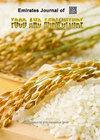Fungal inhibition by lactic acid bacteria (LAB) is modulated in vitro by cocoa fermentation-related conditions: towards a biocontrol of fungi in processing cocoa
IF 0.7
4区 农林科学
Q3 AGRONOMY
引用次数: 0
Abstract
Fungal growth impair strongly the quality of processed cocoa, leading to low crops value for farmers and manufacturers. The antifungal activity of lactic acid bacteria (LAB) from fermenting cocoa was analyzed and the conditions of fungal inhibition were evaluated. Fungi were isolated from stored fermented and dried cocoa beans on sabouraud plate medium. The results showed that, LAB strongly inhibit fungi isolated from fermented cocoa beans notably Mucors and Aspergilli, with Lactobacillus plantarum inducing the stronger inhibition whereas Leuconostoc mesenteroides produced a weaker inhibition. Acids production assayed by HPLC was found to be not related to antifungal activity, since LAB strains producing strong antifungal activity were not necessarly the best acid producers. Maximum fungal inhibition occured at 35 °C in Lactobacillus plantarum and Leuconostoc mesenteroides but also at 30 °C in Lactobacllus casei. Likewise, a narrow acidic pH range (3.0-4.0) allowed full expression of fungal inhibtion in LAB analyzed that decreased progressively toward pH 7.0 and failed at alkalin pH. However, sucrose even at high content (8%) was found to have no effect on antifungal activity of LAB, but its bioconversion product glucose and fructose decreased this activity when concentrations were set at 6 et 2 %, respectively. All together, the results suggest that, LAB may effectively exert fungal inhibition in a narrow timing of cocoa fermentation, with pulp contained sugars as metabolic regulators of this inhibition. These results may contribute to a better management of LAB as starter culture for an efficient inhibition of fungal growth and prevention of cocoa contamination from mycotoxins. Key Words : Antifungal activity ; lactic acid bacteria ; cocoa fermentation ; inhibition variation; pH and temperature ; sugars content.乳酸菌(LAB)对真菌的抑制作用在体外由可可发酵相关条件调节:在可可加工过程中对真菌的生物防治
真菌的生长严重损害了加工可可的质量,导致农民和制造商的作物价值降低。对可可发酵过程中乳酸菌的抑菌活性进行了分析,并对抑菌条件进行了评价。在sabouraud平板培养基上,从发酵和干燥的可可豆中分离真菌。结果表明,乳酸菌对发酵可可豆中分离的真菌有较强的抑制作用,其中对植物乳杆菌的抑制作用较强,对肠系膜Leuconostoc的抑制作用较弱。高效液相色谱法测定的产酸量与抗真菌活性无关,因为抗真菌活性强的乳酸菌不一定是最好的产酸菌。植物乳杆菌和肠系膜白色乳杆菌在35°C时抑菌效果最好,而干酪乳杆菌在30°C时抑菌效果最好。同样,在较窄的酸性pH范围内(3.0-4.0),真菌抑制作用可以在LAB中充分表达,当pH值接近7.0时,真菌抑制作用逐渐降低,而在碱性pH下则失效。然而,即使在高含量的蔗糖(8%)中,也发现蔗糖对LAB的抗真菌活性没有影响,但当其生物转化产物葡萄糖和果糖的浓度分别设定为6%和2%时,这种活性也会降低。综上所述,结果表明,乳酸菌可能在可可发酵的一个狭窄时间内有效地发挥真菌抑制作用,果肉中含有糖作为这种抑制的代谢调节剂。这些结果可能有助于更好地管理乳酸菌作为发酵剂,以有效抑制真菌生长和防止真菌毒素污染可可。
关键词:抗真菌活性;乳酸菌;可可发酵;抑制变异;pH和温度;糖含量。
本文章由计算机程序翻译,如有差异,请以英文原文为准。
求助全文
约1分钟内获得全文
求助全文
来源期刊

Emirates Journal of Food and Agriculture
AGRONOMYFOOD SCIENCE & TECHNOLOGY&nb-FOOD SCIENCE & TECHNOLOGY
CiteScore
1.80
自引率
0.00%
发文量
18
期刊介绍:
The "Emirates Journal of Food and Agriculture [EJFA]" is a unique, peer-reviewed Journal of Food and Agriculture publishing basic and applied research articles in the field of agricultural and food sciences by the College of Food and Agriculture, United Arab Emirates University, United Arab Emirates.
 求助内容:
求助内容: 应助结果提醒方式:
应助结果提醒方式:


